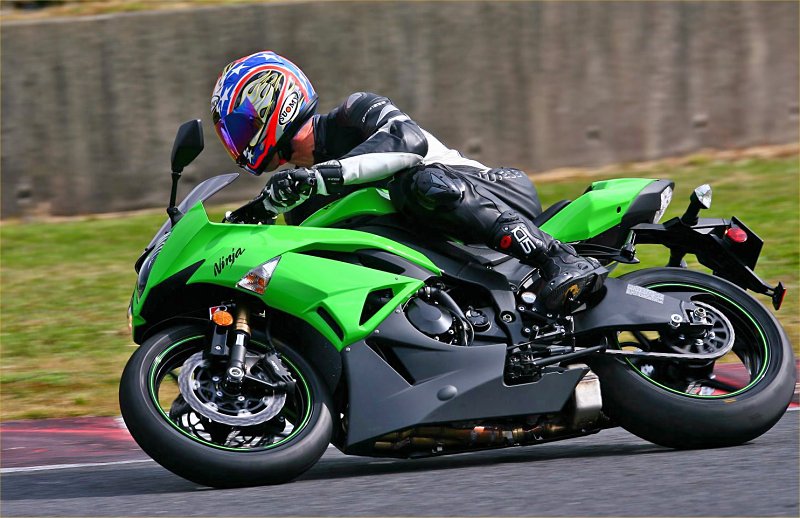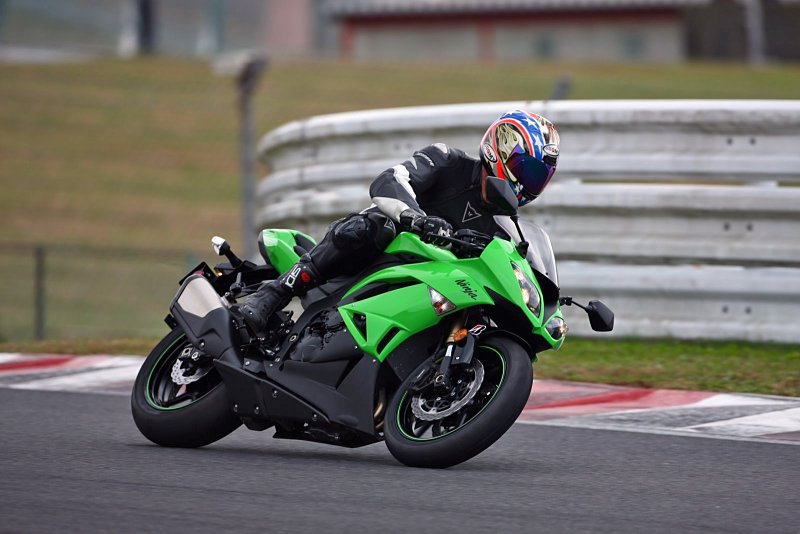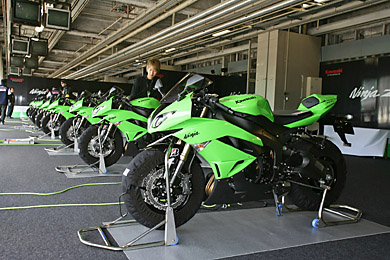
Everyone looks fast down the long main straight at Kawasaki’s Autopolis race track on the southern tip of Japan. The new, 2009 ZX-6R we were riding pulls to something like 150 mph, indicated, before needing to be slowed for the second-gear right-hand turn one. But it’s the rest of the track that truly separates the men from the boys, at the same time emphasizing the merits of Kawasaki’s latest supersport 600.
There’s a series of bends around the turn three and four area that really showcase the bike’s newfound nimbleness. A couple of fast rights lead into two pretty quick lefts before you arrive, somewhat unexpectedly, at a right-hand hairpin. The new Ninja’s ability to shed speed and transition predictably from leaning hard left to turning sharp right is a real measure of how well Kawasaki’s concentrated effort to centralize mass, improve corner entry stability, and reduce overall weight has worked.
Up front there’s a new big-piston Showa fork, which boasts fewer parts than a conventional cartridge fork, yet has three or four times the valve surface and works at a third of the pressure. The new fork arrests dive better than the previous equipment, providing less pitch and flatter ride motions. Mounted with a one-degree reduction in rake for quicker turn in, the fork is backed up by a “race-quality” Ohlins steering damper to maintain stability.
It certainly seemed to do the trick under this six-foot-five, 230-pound rider, who probably hangs on to the bars a lot more than is advised by the experts. You’re supposed to be light on the controls, as you know, but that’s harder than it sounds when you’re tall and trying to move around on the bike for optimal weight transference. As a result, the unshakable front end proved enormously confidence inspiring for this oversized jockey.
Other items contributing to the new ZX-6R’s planted stance are a low-slung side-exit muffler-which replaces the previous model’s underseat unit-and a back-torque-limiting (or slipper) clutch. With this slipper clutch, you can hammer down the 986-yard long Autopolis straightaway, then grab the powerful front brakes via their radial-pump master cylinder and radial-mount calipers, and just bang downshifts all the way to second without concerns about rear-wheel lockup.
The transmission shifts effortlessly, and nobody reported a missed shift or a false neutral the whole time we were there. A close look by Kawasaki engineers at rider ergonomics produced a revised riding position, with bars that are slightly closer to the rider, a seat that is slightly lower, and a tank that provides better arm support in corners and now has a sculpted concavity on top to accommodate a rider in a full tuck. At the rear, Kawasaki’s tech wizards adopted a new swingarm design they say improves feedback.

Of course, if you improve the tactile communication and vehicle stability side of the equation, there’s a real opportunity to capitalize on that with improved performance. But not just at the top end. Last year’s ZX-6R drew criticism because of the need to wring its neck for real power. By lightening and revising various engine components, Kawasaki boosted peak output from 118 to a claimed 124-horsepower at 13,500 rpm (high-speed ram-air reportedly bumps that to 130). More importantly, the engineers achieved a meaningful improvement in the midrange, and even picked up a little more urge at low revs.

New injectors with massaged ports help speed air into the engine, and there are so-called double-bore intake funnels (with a combination of short and long velocity stacks) to make the best of low- and high-speed engine torque. While the low-rev pickup is still somewhat leisurely, the transition from medium engine speeds into the shrieking frenzy of five-figure tachometer readings is now pretty brisk. Last year’s bike was not slow, but this one is seriously fast for a mere 600. Not only is engine output now above 200-hp/liter, Kawasaki somehow found a way to trim 22 pounds from the machine’s overall mass.
That’s not an easy undertaking on any modern 600, but Kawasaki made dramatic reductions to the chassis, losing 15.4 pounds, and to the engine, where 6.6 pounds were pared. The upper engine mounts now connect more directly with the steering tube, while the rear mounts are integral with the frame and rear shock mount. Satisfied that the suspension and engine were mounted securely to the frame, Kawasaki engineers were free to reduce the weight of the main perimeter casting and play with the lateral compliance to improve cornering feel.
While weight is now a believable claim of 421 pounds with all fluids (which makes a big change from the customarily quoted dry weight; usually suggested to be well below 400 pounds), the new ZX-6R can be wheeled around like a bicycle. It can also be hurled around a race track like a dedicated race bike. It was Kawasaki’s specific aim to make the ZX-6R a more-dedicated track mount, and I think the company has succeeded. Since the previous model was extremely approachable and easy to ride on the public road, particularly in contrast to bikes like the Yamaha R6, there was undoubtedly room to compromise.
That begs the question of whether the machine will be as public-road friendly as its predecessor-a question that can only be answered when we get test bikes here. One thing is sure. The bike is huge fun on a track as interesting as Autopolis (which the Japanese, who have no stressed syllables in their own language, pronounce something like Auto-police). Even at my height, the riding position was comfortable and natural. A newly designed gauge is clearly visible ahead, where a large analog tach with a 16,500-rpm redline flanks a digital display panel with unambiguous speed and gear-position readouts.

The electronic injection system fuels the 599cc four in a completely transparent fashion, answering the throttle with eager increases in sound and fury with none of the slow off-idle response you sometimes find on injected fours. While engine performance is relatively linear at modest speeds, there’s a clear and dramatic hit as the revs rise towards five figures where all the carefully calculated resonances begin to play in tune. I think the enhanced mid-range responses will make the bike a much better freeway ride, while the upgraded power at very high revs should put it in the hunt with the Yamaha R6.
Much of the chassis tuning was directed at making the new little Ninja’s handling friendly and predictable, making it accessible to a broader range of riders at the same time as it enables experienced riders to exploit its upgraded agility. If the opinions of the riders in our group are anything to go by, the chassis designer and tuners nailed it.

The bike turns in keenly with little urging, and describes arcs that are precise and predictable. Kawasaki had fitted sticky Bridgestone BT-003 race rubber for our session (BT-016s will be standard fitment), and the black hoops offered extraordinary grip. Only at the end of the day, after much practice, did we see the thin black lines at corner exits that spoke of wheelspin. Feedback from the chassis in mid-corner was well-defined and reassuring, at least at the speeds I was using. And I didn’t hear the really fast guys complaining about their experiences either.
Clearly, this new ZX-6R offers performance well above the needs of your average consumer. But it’s just the ticket for someone who’s looking for a spirited canyon carver as well as occasional track day mount. Who knows, it may prove to be a perfectly well mannered workaday commuter. Not that the 20-something heroes that buy many of the 600s will care about that. Its sticker of $9,799 may be a tad pricey, but the new 2009 Kawasaki ZX-6R has exactly what they are looking for.
More details at Kawasaki’s website here.





